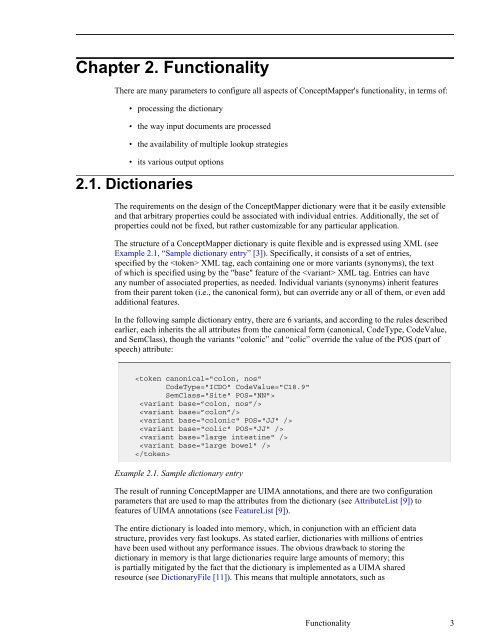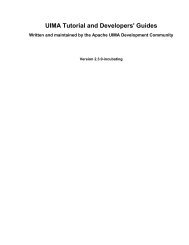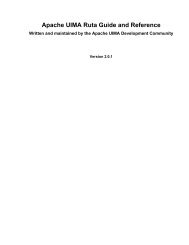Apache UIMA ConceptMapper Annotator Documentation
Apache UIMA ConceptMapper Annotator Documentation
Apache UIMA ConceptMapper Annotator Documentation
Create successful ePaper yourself
Turn your PDF publications into a flip-book with our unique Google optimized e-Paper software.
Chapter 2. Functionality<br />
There are many parameters to configure all aspects of <strong>ConceptMapper</strong>'s functionality, in terms of:<br />
• processing the dictionary<br />
• the way input documents are processed<br />
• the availability of multiple lookup strategies<br />
• its various output options<br />
2.1. Dictionaries<br />
The requirements on the design of the <strong>ConceptMapper</strong> dictionary were that it be easily extensible<br />
and that arbitrary properties could be associated with individual entries. Additionally, the set of<br />
properties could not be fixed, but rather customizable for any particular application.<br />
The structure of a <strong>ConceptMapper</strong> dictionary is quite flexible and is expressed using XML (see<br />
Example 2.1, “Sample dictionary entry” [3]). Specifically, it consists of a set of entries,<br />
specified by the XML tag, each containing one or more variants (synonyms), the text<br />
of which is specified using by the "base" feature of the XML tag. Entries can have<br />
any number of associated properties, as needed. Individual variants (synonyms) inherit features<br />
from their parent token (i.e., the canonical form), but can override any or all of them, or even add<br />
additional features.<br />
In the following sample dictionary entry, there are 6 variants, and according to the rules described<br />
earlier, each inherits the all attributes from the canonical form (canonical, CodeType, CodeValue,<br />
and SemClass), though the variants “colonic” and “colic” override the value of the POS (part of<br />
speech) attribute:<br />
<br />
<br />
<br />
<br />
<br />
<br />
<br />
<br />
Example 2.1. Sample dictionary entry<br />
The result of running <strong>ConceptMapper</strong> are <strong>UIMA</strong> annotations, and there are two configuration<br />
parameters that are used to map the attributes from the dictionary (see AttributeList [9]) to<br />
features of <strong>UIMA</strong> annotations (see FeatureList [9]).<br />
The entire dictionary is loaded into memory, which, in conjunction with an efficient data<br />
structure, provides very fast lookups. As stated earlier, dictionaries with millions of entries<br />
have been used without any performance issues. The obvious drawback to storing the<br />
dictionary in memory is that large dictionaries require large amounts of memory; this<br />
is partially mitigated by the fact that the dictionary is implemented as a <strong>UIMA</strong> shared<br />
resource (see DictionaryFile [11]). This means that multiple annotators, such as<br />
Functionality 3




